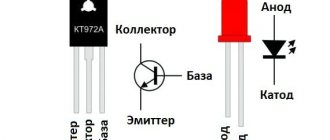Most modern cars are equipped with an alarm system, which is necessary for peace of mind of the driver. The security system allows you to securely close the doors, hood, and trunk from potential intruders. Most often, the driver purchases a car already with an alarm system, rather than installing it separately, which is why he does not know about all the features of the system. A problem such as a constantly burning alarm light can confuse the car owner. If the alarm light begins to light constantly, whereas previously it blinked when the security system was activated, this may indicate a malfunction of the system, but most often the reason is much more trivial, and you can restore the normal operation of the alarm without contacting a service center.
Why is the alarm light constantly on?
There are three main reasons that lead to the fact that the usual blinking mode of the alarm light is replaced by its constant lighting:
- The alarm has been switched to Valet mode. The simplest option, which most often does not indicate a malfunction of the security system;
- The alarm is faulty due to mechanical problems. For example, when the security system is turned on, the door, hood, and trunk limit switches may not retract;
- The alarm is faulty due to software problems or sensor failure.
Depending on what happened to the alarm, the way to solve the problem will change. Let's consider each of them separately.
Flashing light in popular alarm models
Sherkhan
So, our Sherkhan alarm light is constantly on. How to check whether service mode is enabled, and if so, disable it? Note that not only Sherkhan, but most systems have the key combination written on the back of the key fob. The owner should also remember that the service mode indicator is blue. In other words, if the blue light is on on the Sherkhan alarm, the first thing you need to pay attention to is the accidental activation of the maintenance mode. Sometimes, in the case of a key fob with an LCD display, it may display a symbol that resembles one or more Latin “Zs”.
To disable (or enable) the maintenance mode, the owner must press buttons “1” and “3” simultaneously, holding them down for one second.
If everything is pressed correctly, the light goes out. Sometimes, depending on the modification of the security system, the car may respond with sound signals or flashing headlights.
Sherkhan can illuminate almost every event with light bulbs. Sometimes the light bulb will not be blue, but red. A red light anywhere requires attention. If the red light on the Sherkhan 5 alarm is constantly on, you definitely need to pay attention to this. The security system indicates the presence of one of two problems:
- The battery has discharged below the mark for normal engine starting. Most often, it is no longer possible to drive away in such a car;
- The car requires a visit to the service center because the faults are of an extraordinary nature.
Valet mode on the alarm system
Each alarm has a Valet mode, which in Russia is usually called “Valet”. This is a service mode that can be activated on the security system to diagnose or configure the alarm. When the security system is in Valet mode, all standard driver alert functions are disabled and only the door, hood and trunk remote control functions.
Please note: If the vehicle's security system is set to Valet mode, it may respond differently when the engine is started. For example, when starting the engine, it may go out, but remain constantly on only when the engine is turned off.
Activation of Valet mode on an alarm can occur either intentionally or accidentally. Most often, when the driver does not understand why the alarm light is constantly on, this means that he accidentally activated the service mode of the security system. To activate Valet mode, you need to press a certain key combination on the alarm key fob.
Please note: Most often, to switch the alarm system to service mode, it is enough to hold down two buttons on the alarm key fob. In rare cases, switching to Valet mode is organized by sequentially pressing the necessary buttons. For a number of old-style alarm systems, switching to Valet mode is carried out by pressing a button (hidden) in the car interior. Manufacturers of security systems are actively refusing the latter option, since attackers, having the ability to switch the alarm to service mode, can steal a car.
How to disable Valet mode
Depending on the alarm model, the method of enabling and disabling Valet mode will change. Let's look at a few basic options.
Please note: The activation of Valet mode on a car is often indicated by an icon in the form of the letter Z on the alarm key fob (if it has a display).
Button to switch the alarm to Valet mode
If the driver purchased a used car, he may not know where the service alarm button is installed. When installing a security system, most often the service technicians check with the driver where he wants to have this button, so that this place is unexpected for potential intruders. You can often find Valet in the most unexpected places.
We recommend starting your search for the Valet button in the following positions:
- Under the steering column. The most common place to install the Valet button, since the driver can easily reach it at any time. At the same time, this place is the most unsafe from the point of view of intruders, and under the steering wheel there is a possibility of accidental pressing of the button; Please note: When installing the Valet button under the steering column, it is most often covered with an inconspicuous plug to minimize the likelihood of accidental pressing, and also hide the button from prying eyes;
- Under the driver's seat. You also need to look for an element that may look like a stub under which the button is located;
- In the driver's door. A rather rare option for installing a button, since the door can be accessed from outside the car without opening it completely.
As noted above, the location of the Valet button depends entirely on the imagination of the driver who installed the alarm. Sometimes it can be found in completely unexpected places, for example, under the hood or under the rear passenger seats.
Important: A reliable way to find the Valet button is to “read” the technical documentation for the alarm installed in cars. You need to understand from it where the output links are located in the electrical circuit of the security system, and then find the Valet button along the wires from the sensors.
Having found the Valet button in the car, just hold it down for 10-15 seconds to activate or deactivate the service mode. When entering the service mode, the car will indicate this by “blinking” the dimensions and sound signals.
Combinations for enabling Valet mode in alarms
If you cannot find the Valet button, most likely your alarm system is quite modern, and its transition to the service mode is organized by pressing certain keys on the key fob. Let us consider, as an example, several basic methods of activating and deactivating the service mode for popular security system models:
Service mode
A common reason why the alarm light starts to light is when the jack mode is activated. In this case, only the remote closing/opening sensors work. The rest of the anti-theft system is disabled.
In this case, the light is constantly on or blinking. This function is necessary for repair work, but sometimes it works independently due to accidental pressing of the remote control buttons in an activation combination, increased sensitivity of the keys, malfunction of the electronic system due to high humidity or sudden temperature changes, especially in winter.
Methods for exiting the “jack” service state and activating the alarm system on the most common security devices:
- Star Line Twage B6 and Star Line Twage B9 are deactivated using key 2, the corresponding inscription will no longer be displayed, the signal light will go out. Scher Khan Magicar 5 and 6, turning off the “jack” is done by simultaneously holding keys 1 and 3 for a second. After entering the operating mode, the LED in the cabin stops blinking.
- The tomahawk is disconnected from the preventive mode by repeatedly (2 - 3 times) pressing the key fob key “Z”, a combination is possible: 1 hold, 1 short-term, depending on the model.
- Pandora independently checks the connection with the owner through the key fob. If it is missing, the red light in the cabin lights up. Try replacing the batteries; if the result is negative, due to the complexity of the system, you should contact service. The jack mode can be turned on/off with the help of a specialist.
- Sterline, to turn it off, press button 2 once, and the light in the cabin should go out. Systems that do not use key fob buttons to exit the service mode are equipped with special buttons located in the vehicle interior. By default, in the absence of the owner's wishes, they are mounted under the steering column. Holding this button for 10 seconds will deactivate the “jack”, which will be accompanied by several short beeps from the car and the warning light in the cabin will turn off.
After these procedures are completed, the car is ready for use. In case of repeated, unauthorized cases of switching to the service mode, you must contact the service center for diagnostics.
The alarm is faulty due to mechanical problems
Another reason that can lead to a constantly lit alarm light is a mechanical fault. In alarms, it is most often caused by problems in the operation of the limit switches (opening and closing sensors) of the doors, hood or trunk.
The limit switch is a button that is located at the joints of car parts. For example, in the doors or in the trunk. When the limit switch is closed, that is, the door is completely closed, the alarm receives a signal about this.
Please note: Most modern cars have a display that shows which door is open. If there are problems with the limit switches, the doors will also not appear as closed on this graph.
If there are problems with the limit switches, for example, they are out of order or do not close the circuit due to faulty contacts, the alarm will inform the driver about this with a constantly lit light.
Most often, to solve the problem, it is enough to determine which limit switch is not working correctly, then disassemble it and clean the contacts.
Limit switches
Before writing about limit switches, it is necessary to separately mention a feature of the Starline security system. At a good speed, in some cars the air flow, running onto the hood, can lift it slightly. But the Starline hood contacts are located in such a way that the alarm light will light up while driving, indicating that the hood lid is “not closed.”
You can also note the limit switch on the trunk of cars in which the Sherkhan system is installed. While the trunk is not tightly closed (for example, due to non-standard cargo), the blue light on the Sherkhan alarm will be constantly on.
This is what a trailer might look like.
If the owner has checked the “immobilizer” functions and is sure that the service mode is not enabled, it is necessary to check the limit switches of all doors, and not just the hood. If the contact is oxidized, dirty, or the cover presses on it with insufficient force, this is the second reason why the light on the alarm is on. Checking and cleaning usually solves the problem, after which the light goes out.
The alarm is faulty due to software problems or sensors
Another reason, but quite rare, which can lead to the alarm light constantly burning, is a software failure. Most often it is associated with a malfunction of one or more sensors (impact, volume, body position, and so on). It is unlikely that you will be able to determine on your own, without diagnostic equipment, which specific sensor has failed and correct its operation. Therefore, in such a situation you need to contact a service center.
Failures in the operation of the control unit software are even less common. Only service specialists can eliminate them.
( 18 votes, average: 4.39 out of 5)
The operating modes of the vehicle's car alarm are controlled by the alarm indicator light. The alarm status is monitored without using a key fob with an LCD screen. Depending on the mode the security device is in, the alarm light is on, blinking or at rest (not lit). The article presents a brief analysis of LED indicators of several types of alarms.
Options for lighting the alarm light
Each car alarm developer includes a certain state of the LED in the operating algorithm. Under different conditions, it lights up, blinks, alternates flashes or is in an extinguished state.
Below is a table of the states of the StarLine family alarm lamps (on continuously, blinking, at rest) located on the car.
| Light bulb status | ||||
| Continuous burning | Does not burn | Slow blink | Rapid blinking | Flashes in series (number) |
| With the engine running from a distance | + | |||
| With turbo timer enabled | + | |||
| With immobilizer enabled | + | |||
| Disarmed | + | |||
| Security alarm | + | |||
| With open doors or hood, trunk (with ignition on) | + | |||
| With daily auto-start of the car engine | 2 | |||
| With automatic start based on temperature | 3 | |||
| With daily autostart based on temperature | 4 | |||
| Enabling the “VALET” service mode | 5 |
The PANDORA car alarm (more about the Pandora car alarm manufacturer) uses a three-color light bulb. If the car alarm indicator on your car is lit or blinking, please see the table below.
| State | |||
| Continuous glow (color) | Blinks periodically (light bulb color) | Does not burn | LED flash colors |
| Armed | Red, single, short | ||
| Ready for automatic, passive security installation | Red | ||
| Enabling “Hands Free”, “Panic” | Red | ||
| Alarm disabled (disarming) | Alternating red, green | ||
| Disarmed | + | ||
| Disabling the immobilizer | + | ||
| Car alarm maintenance (ignition off) | + | ||
| Maintenance (ignition on) | Green | ||
| Time channels are turned on | 1 green | ||
| VALET button pressed | 1 orange | ||
| Disarming the car alarm, an alarm from the door sensors was triggered | 2 red | ||
| Disarming, alarm triggered when ignition is turned on | 3 red | ||
| Disarming, shock sensors triggered | 2 green | ||
| Disarming, additional sensor triggered | 3 green | ||
| Disarming, hood and trunk sensors triggered | 2 orange | ||
| Disarming, the machine's network voltage has dropped below the permissible level | 3 orange | ||
| Anti-Hi-Jack mode | Single green |
LED indication of the SHERIFF device on the car (more information about the Sheriff car alarm manufacturer) – table
| Modes | State | |||
| Constant glow | The light is blinking | + | ||
| Lack of security | + | |||
| The alarm system is armed by passive arming | Often | |||
| Car alarm protected | Slowly | |||
| Triggering of the main zone 1 of the vehicle impact sensor | 1 | |||
| Triggering of the main zone 2 shock sensor | ||||
Triggering of hood and trunk triggers 3
Triggering of HF triggers in doors
Transponder registration detected Alternating 1 long and 3 short
| Modes | State | |||
| Lit | The light is blinking | Switched off | Number of LED flashes with pause | |
| Option "VALET" | all the time | |||
| The time until the alarm is armed in passive mode is counted down | In frequent | |||
On state Slow speed
Passive engine blocking activated At a very slow pace
Remote activation of “Anti-Hi-Jack” is performed for 5 s, ignition is on
Car alarm is triggered by shock sensors 1
Various alarm light states
Today, vehicles without car alarms are some classic models from the distant Soviet period. Security systems are installed at service stations and supplied with vehicles from manufacturers. Like all technical equipment, they are subject to breakdowns and failures. A light indicates a failure; it is on all the time, blinks without stopping, or goes out completely. Let's look at the most common situations.
Reasons for the constant burning of a light bulb
A constantly burning car light indicates that something is wrong with the car alarm. The reasons can be very different, among the main ones why it burns are considered:
Accidental activation of the “VALET” mode. In standard modes, it is activated in car alarms by combinations of key fob buttons. Unintentionally pressed activation buttons cause the LED to glow continuously, which causes unpredictability in the actions of the car driver, when the light does not blink, but is on all the time. If the service alarm mode is accidentally activated, the security options are deactivated. There is an option that remotely controls the opening and closing of the door locks, hood, and trunk of the car. Bringing to working condition is carried out in accordance with the operating instructions for the car alarm.
Technical breakdowns. In cases where the light should blink, but it stays on, problems should be looked for in the technical component of the alarm. One of the reasons is problems with limit switches. The essence of the problem often lies in oxidation and burnout of the limit switch contacts. As a result, the car alarm circuit does not close, the LED is constantly on, and the car is unprotected. The problem is eliminated by cleaning the contacts and replacing the switches. Another problem, when the car alarm light does not blink but is on, occurs when the device’s sensors fail. The problem is properly resolved in service centers.
Software or hardware failure. If the LED on the car continues to light after checking the above reasons, there is a problem with the main car alarm unit. The service center specialists will make an accurate diagnosis, followed by troubleshooting.
Reasons for the frequent blinking of the alarm light
A common problem with vehicle alarms is the frequent blinking of the indicator light, followed by blocking the engine from starting. One of the reasons is the incorrect operation of the limit switches, the closing parts of the car. It is enough for one of them to fail and the correct operation of the device fails. It is enough to clean the contacts or replace the switches.
Another reason is the incorrect location of the power unit temperature control sensor. The car alarm LED will start working normally if the sensor is reinstalled according to the instruction manual.
The alarm light stopped lighting - reasons
In the practice of car enthusiasts, there are situations when the alarm LED does not light up or blink at all. Experience shows that the main reasons can be as follows:
- The main unit overheats;
- Installation errors, when the power is turned off, the alarm returns to factory settings;
- Contacts, wiring, fuses burn out.
Diagnostics by specialists will help to accurately determine problems in the security system on the car. For a car owner ignorant of the nuances of electronics, it is difficult to identify the reason why the LED does not light up. Service centers that have equipment and tools will carry out alarm restoration in the most efficient manner so that the light bulb serves its purpose: it blinks when needed; when necessary, it lights up.
So, this article discusses the main reasons for what problems there may be in car alarms, determined by the state of the light bulb. It burns continuously; blinks inappropriately; does not light up.
As a result, it was revealed that the signaling problems were related to the operating state of the limit switches. Sometimes the cause of incorrect behavior of the car alarm LED is sensors. There are problems with the main processing unit: hardware failure; incorrect operation of the software.
Timely diagnosis and troubleshooting will protect the car from intruders and theft.
Most modern cars are equipped with factory alarms. Often, a car owner buys a used car with an already installed alarm system. In both cases, the car owner may not know all the intricacies of the security system of his vehicle. A constantly burning alarm light is a sign that the car’s security system is malfunctioning. In this case, it is necessary to understand the reasons for the constantly working indicator and eliminate them in order to restore the system’s functionality.
If the light on the alarm key fob
p, blockquote 36,0,0,0,0 —>
Constantly on
p, blockquote 37,0,0,0,0 —>
1. Car alarm works normally
p, blockquote 38,0,0,0,0 —>
The reason for the constant glow of the diode may be a breakdown of the control transistor in the key fob. It is located separately on the board or built into the control chip. In the second case, it is cheaper to change the key fob or the entire board. If the transistor is faulty, it can be soldered to a working one. Such repairs require appropriate qualifications.
p, blockquote 39,0,0,0,0 —>
2. The alarm does not respond to key fob signals
p, blockquote 40,0,0,0,0 —>
The likely cause is a software or technical failure of the key fob.
p, blockquote 41,0,0,0,0 —>
The first thing to do in such a situation is to try to temporarily (for 15-20 minutes) remove the key fob battery. Just in case, you need to check the residual voltage on the battery. If it is 20 percent less than the nominal value, it should be replaced.
p, blockquote 42,0,0,0,0 —>
When the battery is reinstalled, the microcontroller of the key fob is rebooted, after which it can return to working condition. If a similar situation repeats again within a short time (a month), the key fob should be replaced, after which it must be “registered”.
p, blockquote 43,0,0,1,0 —>
Does not burn
p, blockquote 44,0,0,0,0 —>
1. Car alarm works normally
p, blockquote 45,0,0,0,0 —>
Most likely, the cause of this malfunction is a failure of the LED or corrosion of its solder joint. It is necessary to disassemble the key fob, ring the LED and the additional resistor with a multimeter.
p, blockquote 46,0,0,0,0 —>
p, blockquote 47,0,0,0,0 —>
If the LED is working, you need to solder the installation location of the diode into the board. Sometimes corrosion (cold soldering) is not visible even under a magnifying glass.
p, blockquote 48,0,0,0,0 —>
2. The alarm does not respond to key fob signals
p, blockquote 49,0,0,0,0 —>
Typical fault. The most likely causes are a low battery or a faulty key fob.
p, blockquote 50,0,0,0,0 —> adsp-pro-2 —>
Some car owners limit themselves to removing the battery from the key fob and checking the residual voltage with a multimeter. After making sure that it corresponds to the nominal value, they decide to replace the key fob. This is not entirely correct. Under load, a heavily discharged battery may not provide the current necessary for normal operation of the key fob circuit. Therefore, it is safer to replace the battery.
p, blockquote 51,0,0,0,0 —>
If the key fob was carelessly dropped into a puddle or other aquatic environment, or stored in damp conditions, it is possible that mold and corrosion may have formed on its circuit board, which leads to large leakage currents and inter-track short circuits. In such a situation, the battery may discharge within a week.
It is necessary to disassemble the key fob and clean its board with alcohol. Other solvents should not be used.
p, blockquote 52,0,0,0,0 —>
Main reasons
There are several main reasons why the security system indicator lights up with a constant, unblinking light.
- The most common reason for a constantly lit alarm indicator is that the Valet security system mode is intentionally or accidentally turned on. In this mode, the indicator light lights up continuously. However, the car is not under security. The car owner is notified of the activation of this mode by an inscription on the electronic display of the alarm key fob.
- Another common reason for a constantly burning light is a malfunction of the limit switches (limit switches) of the opening parts of the car body, that is, in the doors, trunk or hood.
- A less common, but still common reason for a constantly lit indicator is a software failure, hardware alarm error, or failure of individual sensors.
For some alarm models, a constantly lit indicator may be associated with the activation of certain security system modes: “Panic”, “Hands Free”, with the immobilizer turned on, when starting the engine remotely, etc. In this case, removing the constantly lit indicator is quite simple. You need to set the alarm to standard security mode or turn it off temporarily.
Causes
What could such a light bulb mean? Most often, this is a signal to the driver (or owner) that something is wrong with the system. Let's look at the most common cases of why the alarm light is constantly on. There can be many reasons, but there are only three main ones:
- accidental pressing of buttons on the key fob;
- there is no contact on the door ends or hood/trunk lids;
- the system as a whole or individual sensors do not work.
If for the last case the recipe is universal - a service center, then the first two can often be solved by yourself.
We’ll talk about limit switches below, because in almost all cases the cause is the same, and can be solved using the same recipe. In addition to the fact that the alarm light is constantly on, this can be understood by other signs. Now let's look at the first point - accidental pressing of buttons on the key fob.
If the owner carries the key fob in his pocket, then a random movement can press a sequential combination that turns on the so-called service mode. While the mode is working, the blue alarm light on the owner's call sensor lights up. The mode is intended for servicing both alarm components and the entire machine as a whole, and is turned on by technicians at the station.
In this mode the locks work, and that's all. Sometimes in documentation this mode is called “valet” or “valent”.
However, practice shows that the mode can be turned on accidentally.
Valet mode in alarm
Various manufacturers of security systems for cars include several lighting modes for the alarm indicator in their software. In different modes it flashes, is at rest or is constantly on. Most security system manufacturers provide a Valet service mode when the car is unprotected.
Valet is primarily intended for car maintenance and repair, when the security system may interfere with car service workers. Valet can be accidentally or intentionally turned on by the car owner, in which case a constantly lit alarm indicator indicates that the car is unprotected. In this mode, the car owner can only remotely open and close the doors, luggage compartment and hood.
How to disable Valet
The option to disable Valet mode depends on the possible ways to enable it. It is deactivated either by pressing a button inside the car, or using the alarm remote control by pressing a combination of buttons.
Button to switch to mode
The “Valet” button can be located anywhere in the car: both in the cabin and in the luggage compartment or even the engine compartment. It is often hidden in a particularly inconspicuous place so that potential car thieves are not tempted to disable the entire security system with a simple press of a button.
As a rule, when installing an alarm, service workers check with the car owner about the desired location of the button to turn on and off the Valet mode. If the car owner does not know where such a button is located, he will have to look for it. The most expected button locations are the following places.
- Under the steering column is the most commonplace location of the button, which is also the most unsafe. The area under the steering column is convenient as the driver can press it without leaving the driver's seat. However, potential hijackers look for it first of all there. As a disguise, the button can be covered with an ordinary plug, which will also prevent accidental pressing.
- Under the driver's seat is another convenient but banal option, which is also often masked with a plug.
- In the driver's door - a dubious option, since in this case it can be accessed from outside the car.
In general, the placement of the button is limited only by the imagination of the person on whose initiative the alarm was installed. Therefore, in order not to waste time on empty searches, it is better to carefully study the technical documentation of the alarm system.
Disabling Valet mode using a button looks the same for almost all car alarm manufacturers.
- You need to start and then turn off the car engine.
- After 10 seconds, you need to press the Valet button and hold it for several seconds, or turn the switch to the “Off” position.
- The driver is notified when the mode is turned off by a double horn sound, after which the indicator light goes out.
Combination to turn on Valet
Another option for disabling the Valet mode of the car alarm is possible using a remote control, that is, a key fob. To do this, you need to press one of the key fob key combinations, and the key combination, as well as the sequence and duration of pressing, can vary significantly among different manufacturers of security systems.
The exact combination for disabling the service mode in a specific security system model can be found in the car alarm user manual. The key combination for the most common car alarms is as follows.
- For security systems of the popular Scher-Khan brand, turning on and off the Valet mode is done by simultaneously pressing and holding buttons 1 and 3 for one second. You cannot overpress, since pressing these buttons for 2 seconds will turn off the shock sensor.
- The Valet mode in the StarLine family of alarms is disabled by pressing button 2 once.
- In Tomahawk car alarms, the mode is turned off by pressing the Z button; usually you need to press it twice - once once and once while holding the button. For some alarm models of the company, the method of disabling may differ, so you should first study the manual for using the specific security system.
- For Alligator brand alarms, the mode is turned off by simultaneously holding buttons 2 and 3 for 3 seconds.
Solutions
In a situation where the alarm light constantly blinks when driving in Starline, it is necessary to take some measures. Let's take a closer look at them.
Check the hood and door switches
A common reason why the alarm light blinks when driving on a Starline A91 is problems with the contact on the hood. To check, follow these steps:
- If the LED blinks while driving, press the third button on the key fob.
- Look at the display and note the cause of the problem.
The Starline alarm will show why the LED blinks while driving. If the cause is one of the limit switches, adjust it and ensure normal contact connection.
Inspect the temperature sensor
The next explanation for why the LED on the Starline A91 constantly blinks while driving is a problem with the temperature sensor. First, try reinstalling it from the pipe to the engine bracket. In most cases, this option helps solve the problem. After that, check whether the light is blinking or not.
To check, discard one of the wires (orange or orange-gray). If, after turning off the sensor, the LED no longer blinks while driving, this is the reason. Replace the device with a new one. Please remember that autostart based on temperature depends on the operation of this device.
Return the system to normal mode
If the LED blinks while driving on Starline A93, follow these steps to solve the problem:
- Open the doors using the key fob and remove the car from the security system.
- Insert the key into the ignition and turn it.
- Apply the foot brake.
After completing these steps, the LED on Starline blinks in standard mode. In a situation where these actions do not produce results, proceed to the next step.
Enable Slave
Sometimes, if the LED in Starline A93 blinks while driving, try turning on the Slave option. Two methods are used for this.
Using the service button:
- Enter CAN programming mode. To do this, press the service button and hold it until five siren signals appear. While they are triggered, keep the button on. After this, release the key.
- Use buttons 2 and 3 to enter program mode (AF). Press the 3rd button first for a long time, then briefly. Go to parameter #9.
- Set to 1 - Enabled.
Via PC:
- Enter the CAN settings via the programmer.
- Activate the Slave option.
- Save your settings.
Check brake ground contact
In a situation where the Starline LED blinks while driving, check the operation of the mass. To do this, do the following:
- Have a helper apply the brake.
- Walk around the car and check all the STOP lights, as well as the contacts in the sockets and the operation of the frog on the brake.
If contact is lost, do not be surprised by the light blinking while driving. Due to the fact that the defect is floating, the LED will blink periodically.
Mechanical damage to the alarm
Mechanical damage, manifested by a constant lighting of the indicator, is usually associated with limit switches (limit switches) of the doors, luggage compartment or hood. Limit switches are the simplest opening-closing sensors, which are buttons connected to an alarm system. In the closed position they are pressed and close the electrical circuit; in the open position they open. Damage to the limit switches can be caused by:
- oxidation of contacts in conditions of high humidity or in winter;
- loose fit as a result of deformation of the body part due to an accident or improper installation;
- failure due to mechanical impact or impact.
When the electrical network is disconnected, the alarm perceives the body part as open. As a result, the alarm indicator light lights up continuously.
On modern cars equipped with a display, identifying the problem of an inoperative limit switch is quite simple. In a graphic image of a model car, a door or body part with a non-functioning limit switch will also be displayed as not closed.
To solve the problem, you need to visually inspect all the limit switches of the car for contact oxidation. If an oxidized limit switch is detected, it must be disassembled and the contacts cleaned.
If the cause of the limit switch malfunction is mechanical damage, then it needs to be replaced with a new one. If incorrect positioning of the limit switch is detected, the position of the limit switch must be adjusted to that required for proper operation.
technical issues
Another reason that gives rise to a constant light on, indicating problems with the alarm system of your car, is a malfunction of the “limit switches” of the doors and hoods of the engine and luggage compartments. They are called small plastic push-button sensors that are connected to the security system circuit. When the car is closed, they are pressed, closing the electrical circuit. If the sensor fails to detect a short circuit:
- Oxidation of contact in conditions of high humidity and winter time.
- Loose fit due to poor installation or deformation of body elements as a result of an accident.
- Sensor failure as a result of mechanical impact or shock.
Malfunction of programs or sensors
A fairly rare, but possible reason for the indicator to be constantly on is a software failure or malfunction of individual sensors. Special security system meters include sensors for mechanical impact (shock), changes in volume in the cabin, body position, etc. If one of the sensors breaks down, the system perceives the situation as an emergency, which notifies the car owner using an indicator. In this case, to diagnose the faulty sensor, you will have to contact a specialized service.
Also, a constant indication may be caused by a software or hardware error in the electronic alarm control unit. You can try to reset the alarm by turning off the battery power. If the problem persists, it is difficult to solve it yourself, so it is better to contact a service center
In any case, the constant burning of the indicator light is a sign that the car is not under reliable alarm protection, therefore, the safety of owning the car is reduced. By finding the reason for the constant light of the indicator and eliminating it, you can restore reliable protection for your car using a car alarm.
“>











